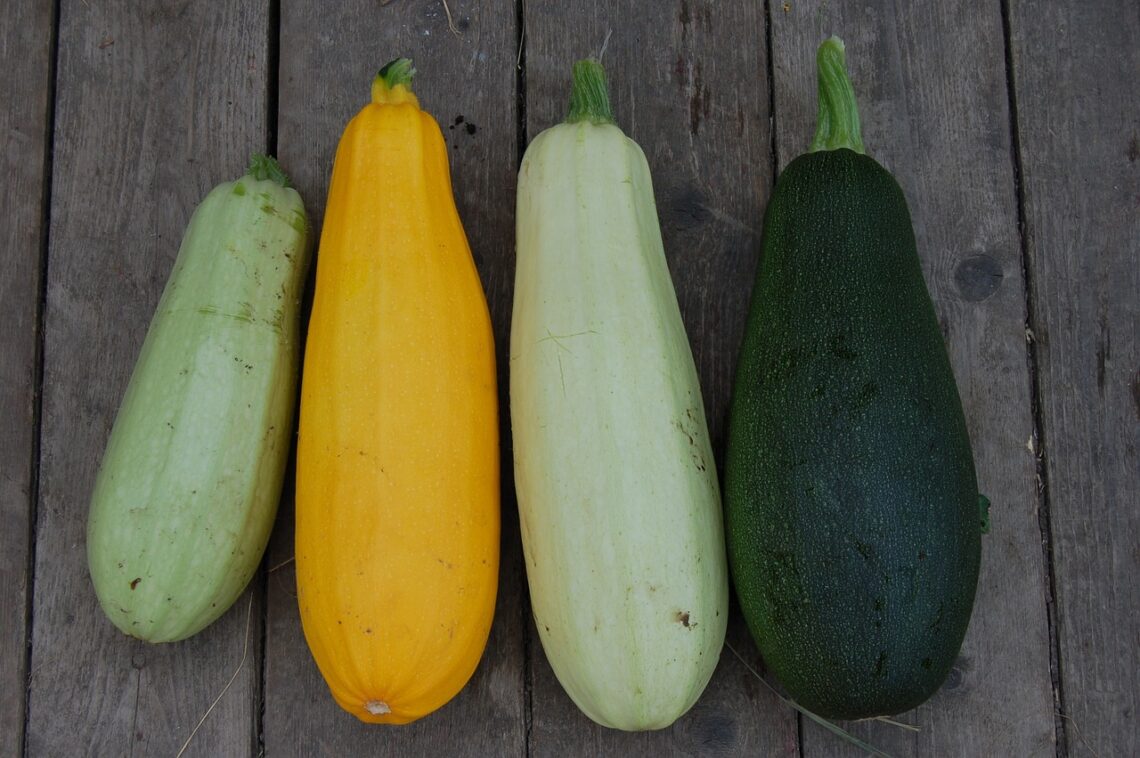
15 Common Zucchini Growing Problems
Are your zucchini plants not performing as expected? Zucchini is a fantastic addition to any garden, offering a rewarding harvest with its fast-growing nature and versatility in the kitchen. However, this seemingly simple vegetable can sometimes present unique challenges, frustrating even seasoned gardeners. Whether it’s pests nibbling on your plants, mysterious diseases appearing out of nowhere, or poor fruit development, zucchini plants can encounter a variety of issues. In this guide, we’ll walk you through 15 common zucchini growing problems and provide actionable solutions to ensure your plants thrive and produce a plentiful harvest.
1. Powdery Mildew
Powdery mildew is one of the most common fungal diseases that affect zucchini plants. This disease manifests as a white or grayish powder on the leaves, stems, and even flowers of the plant. It thrives in warm, dry conditions but can spread rapidly in humid environments as well. The biggest issue with powdery mildew is that it hampers the plant’s ability to photosynthesize by covering the leaf surfaces, leading to stunted growth and reduced fruit production.
Solution: The best way to combat powdery mildew is through prevention. Start by ensuring your zucchini plants are well-spaced to allow for good air circulation. This reduces the humidity levels around the plants, making it less favorable for mildew to develop. Water your plants at the base, avoiding wetting the leaves, especially during the late afternoon or evening. If you notice early signs of powdery mildew, treat the plants with a homemade fungicide made from baking soda and water or use a commercial organic fungicide. Prune affected leaves to stop the spread of the disease and keep the garden clean by removing plant debris where the fungus might overwinter.

2. Blossom End Rot
Blossom end rot is a distressing issue for many zucchini growers. This condition causes the blossom end of the fruit to turn black and rot. It’s often due to a calcium deficiency in the plant, but it’s not always about the lack of calcium in the soil. Instead, it usually results from inconsistent watering, which hinders the plant’s ability to absorb calcium from the soil.
Solution: The key to preventing blossom end rot is maintaining consistent soil moisture. Zucchini plants need regular watering, especially during fruit development. Avoid letting the soil dry out completely between waterings, but also ensure it’s not waterlogged. Applying mulch around the base of the plants can help retain moisture and regulate soil temperature. Adding calcium-rich amendments like crushed eggshells or garden lime can also help, but remember that the primary issue is water management. If you’re dealing with blossom end rot, remove the affected fruits to allow the plant to focus its energy on developing healthy ones.
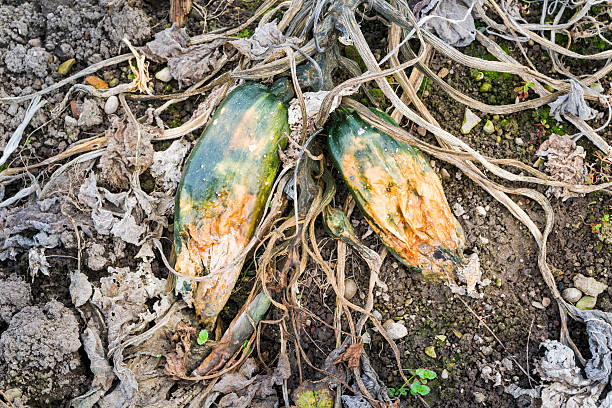
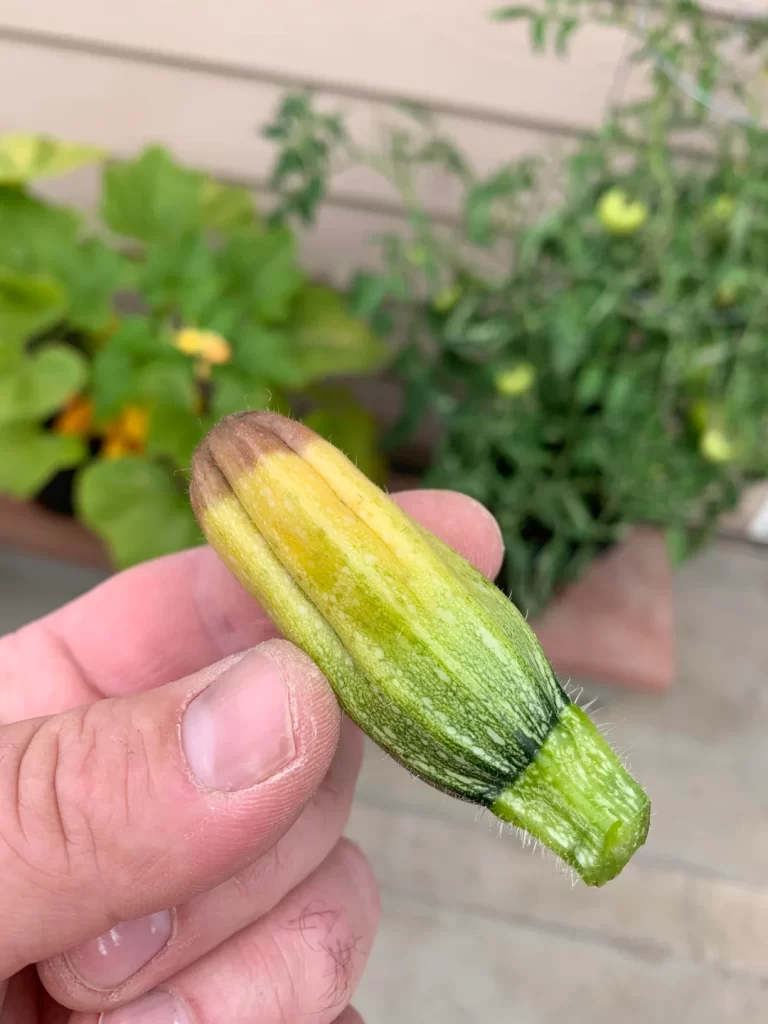
3. Squash Vine Borers
Squash vine borers are one of the most devastating pests for zucchini plants. These moth larvae burrow into the stems of the plants, feeding from the inside and causing the plant to wilt and eventually die. The adult moths lay their eggs at the base of the plant, and once the larvae hatch, they immediately start boring into the stem, making early detection difficult.
Solution: Prevention is crucial when dealing with squash vine borers. Start by using row covers to protect your plants from adult moths laying eggs. You can also wrap the base of the plants with aluminum foil or a cloth barrier to deter egg-laying. Regularly inspect the base of your plants for signs of borers, such as small holes or sawdust-like frass. If you detect an infestation, carefully cut open the stem to remove the larvae, then cover the damaged area with soil to encourage root growth. Crop rotation and clearing plant debris at the end of the season are also effective long-term strategies to reduce squash vine borer populations.
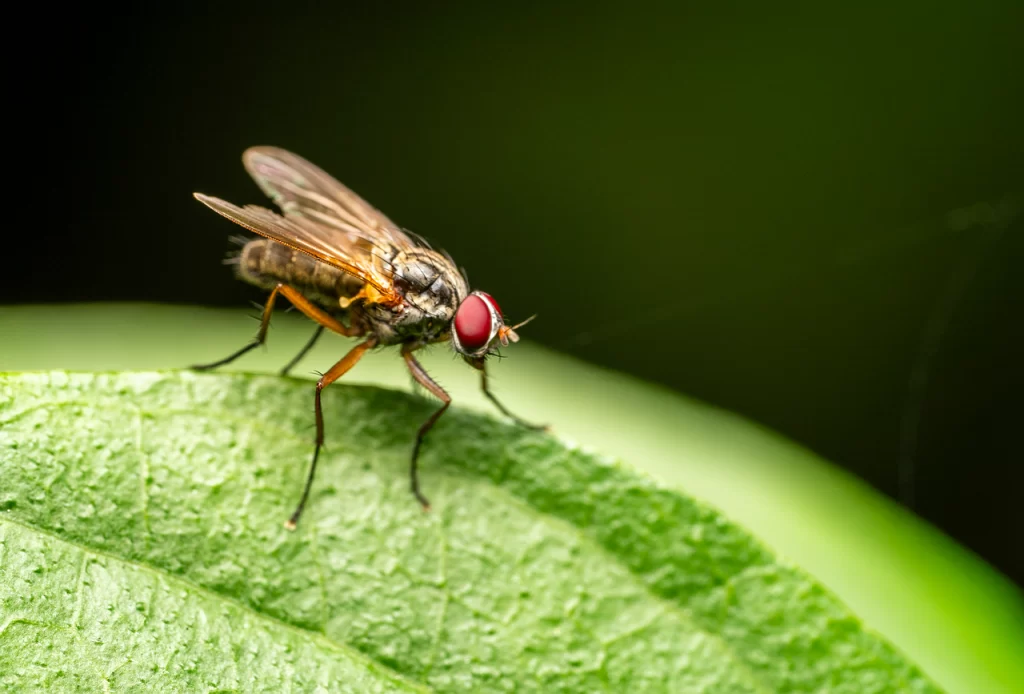
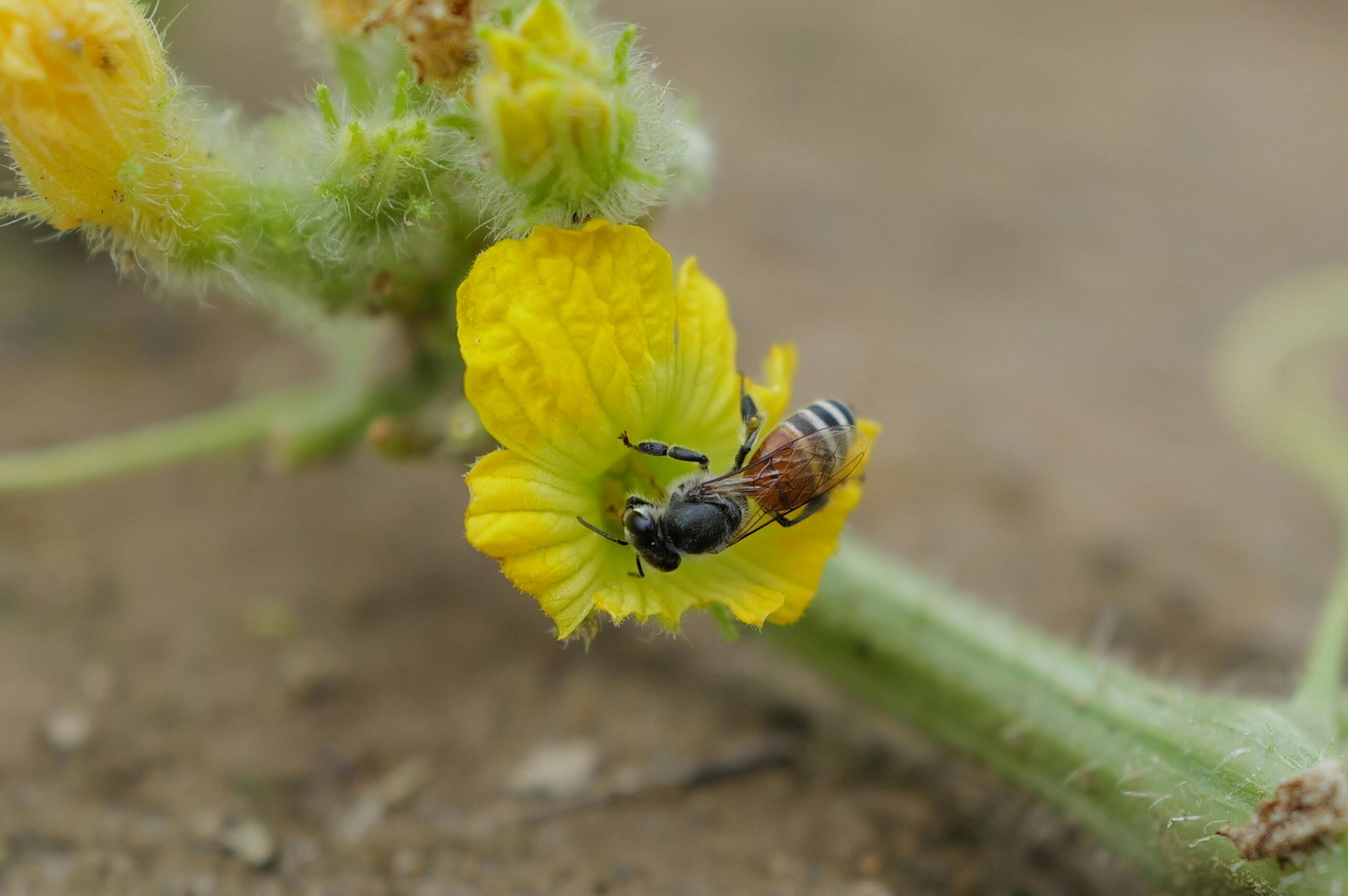
4. Aphid Infestation
Aphids are small, sap-sucking insects that can quickly weaken zucchini plants by feeding on the leaves and stems. These pests are often found on the undersides of leaves, and they can multiply rapidly. Aphids also secrete a sticky substance called honeydew, which can lead to the growth of sooty mold on the leaves, further reducing the plant’s ability to photosynthesize.
Solution: Controlling aphids requires a multi-faceted approach. First, encourage natural predators like ladybugs, lacewings, and parasitic wasps to your garden, as they feed on aphids. You can purchase these beneficial insects or plant flowers that attract them. If the infestation is mild, spraying the plants with a strong jet of water can dislodge the aphids. For more severe cases, use insecticidal soap or neem oil, which are effective yet gentle on the plants. Keep your garden clean of weeds and debris, as these can harbor aphids and make your zucchini plants more susceptible to infestation.
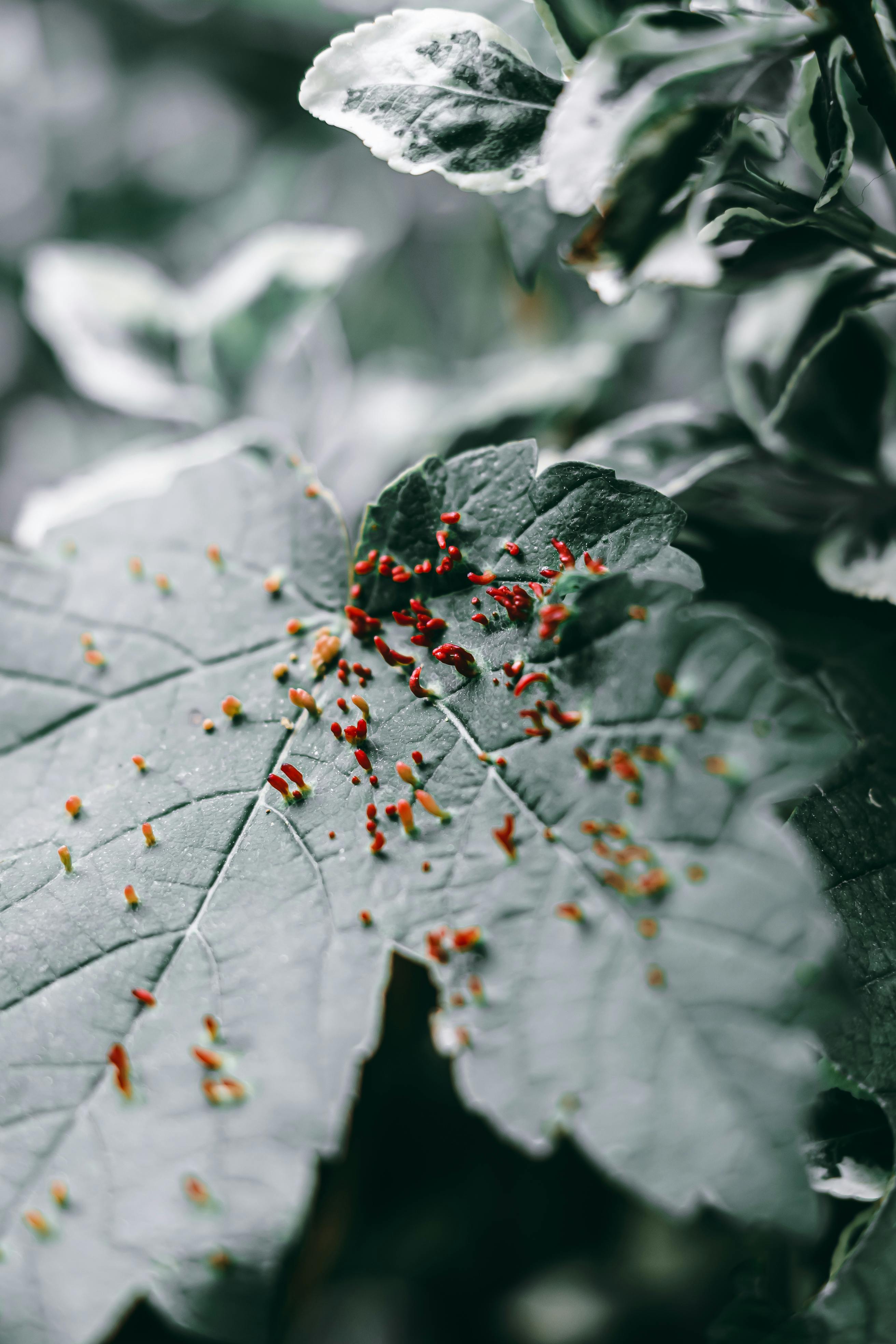

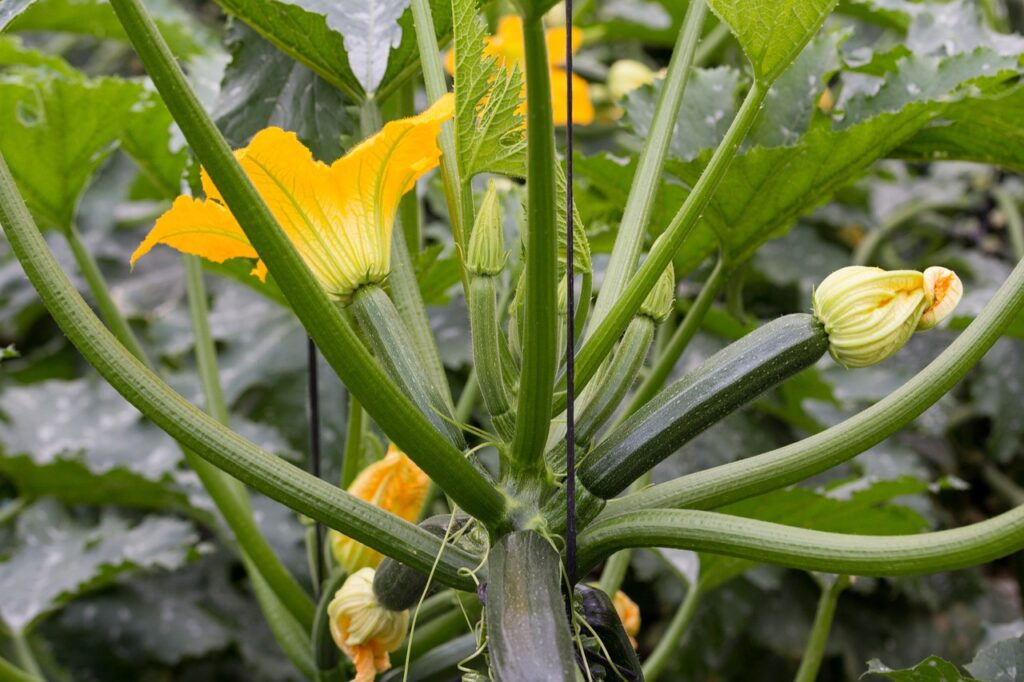
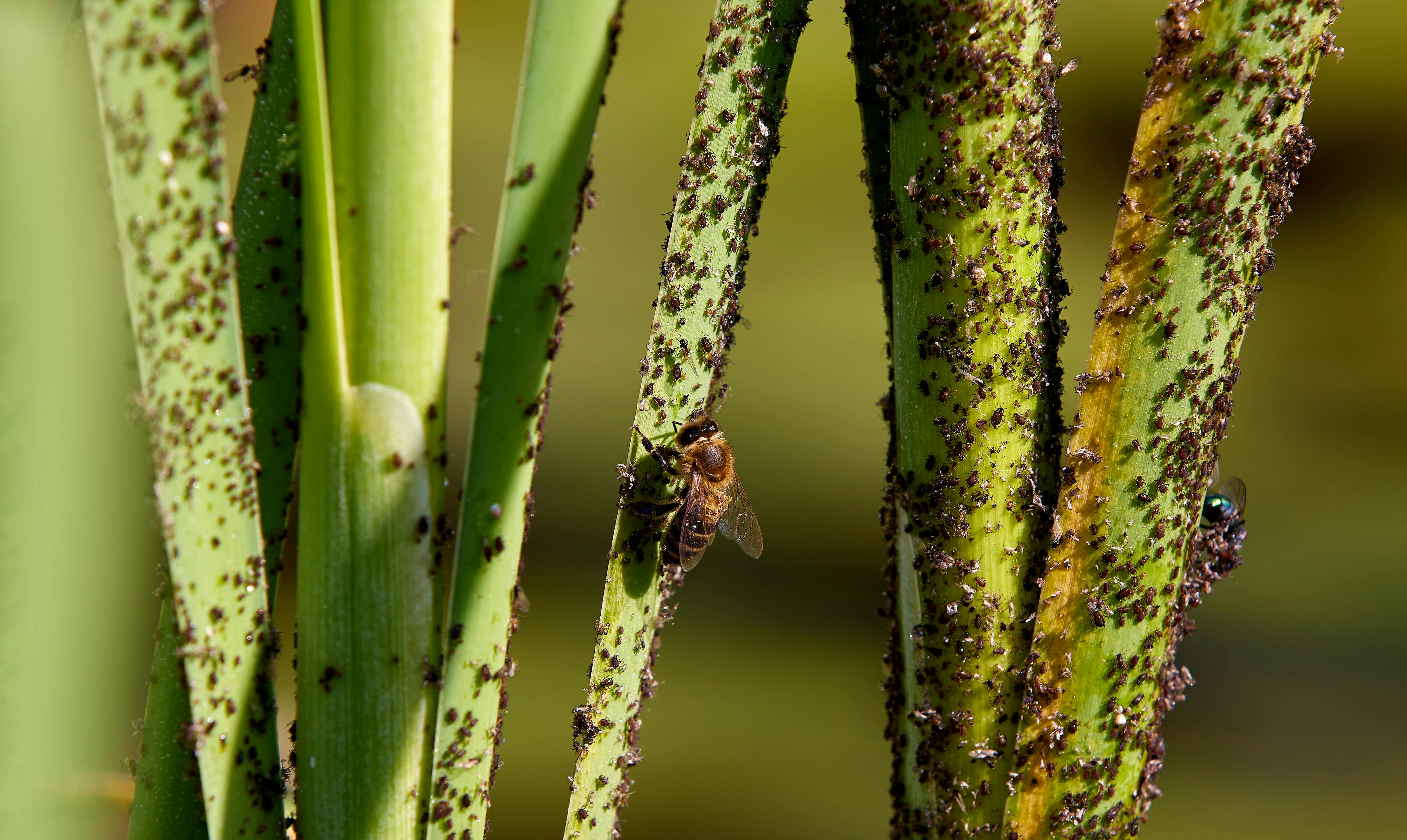
5. Poor Pollination
Zucchini plants rely heavily on pollinators like bees to transfer pollen from the male flowers to the female flowers. Without adequate pollination, you may notice that your zucchini fruits are small, misshapen, or fail to develop at all. This can be particularly frustrating when your plants appear healthy, but the fruit set is disappointing.
Solution: To improve pollination, attract more pollinators to your garden by planting flowers that bees love, such as marigolds, lavender, and sunflowers. You can also try hand-pollinating your zucchini flowers if natural pollinators are scarce. This involves using a small paintbrush or cotton swab to transfer pollen from the male flowers (which have a thin stem) to the female flowers (which have a small fruit at the base). Pollination is most successful in the early morning when flowers are open and receptive.

6. Overwatering
Overwatering is a common problem that can lead to root rot and other water-related issues in zucchini plants. Zucchini plants need consistent moisture, but too much water can drown the roots, depriving them of oxygen, and create a breeding ground for fungal diseases like pythium and phytophthora.
Solution: To avoid overwatering, ensure your soil is well-draining. You can improve drainage by adding organic matter like compost or sand to your soil. Water your zucchini plants deeply but infrequently, allowing the top inch of soil to dry out between waterings. Watering early in the morning is ideal, as it gives the plants time to absorb moisture before the heat of the day and allows excess water to evaporate. Mulching around the base of the plants can help retain moisture and reduce the need for frequent watering, but be cautious not to overdo it.
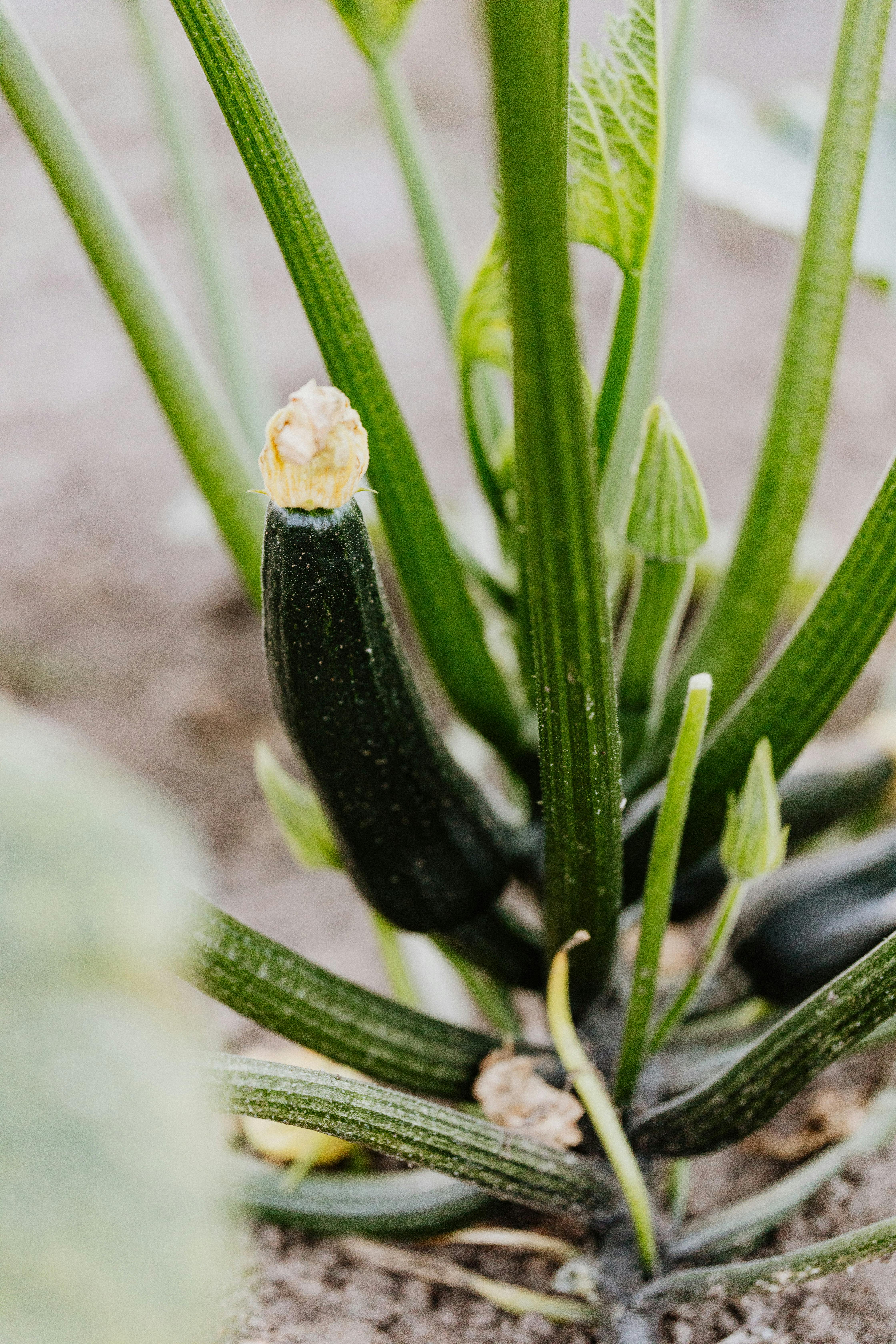
7. Underwatering
Underwatering can be just as detrimental as overwatering, especially during the hot summer months when zucchini plants need plenty of water to support their rapid growth. If your plants aren’t getting enough water, you may notice wilting, yellowing leaves, and small, tough fruits.
Solution: Establish a regular watering schedule and monitor the soil moisture closely, especially during dry spells. Zucchini plants need about 1-2 inches of water per week, but this can vary depending on your climate and soil type. Water deeply to encourage deep root growth, which helps the plants withstand periods of drought. Mulching is also beneficial for retaining soil moisture and reducing the need for frequent watering. If you notice signs of underwatering, give your plants a thorough watering to revive them.

8. Nutrient Deficiencies
Zucchini plants are heavy feeders, requiring a steady supply of nutrients to produce healthy foliage and fruit. A lack of essential nutrients, such as nitrogen, phosphorus, or potassium, can lead to yellowing leaves, poor fruit development, and overall weak growth. Deficiencies can also make the plants more susceptible to diseases and pests.
Solution: Regularly fertilize your zucchini plants with a balanced fertilizer or compost to ensure they get the nutrients they need. A slow-release granular fertilizer can be applied at the start of the growing season, followed by liquid feedings every few weeks. If you notice specific deficiency symptoms, like yellowing between the veins of leaves (a sign of magnesium deficiency), you can apply targeted amendments such as Epsom salts or a specialized fertilizer. Conducting a soil test before planting can help you determine if any additional amendments are needed.
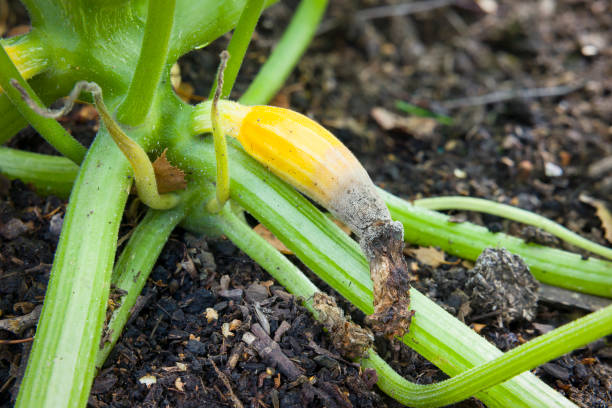
9. Cucumber Beetles
Cucumber beetles are small, yellow-green beetles with black spots or stripes that can wreak havoc on zucchini plants. They feed on the leaves, flowers, and fruits, and can also transmit bacterial wilt and cucumber mosaic virus. If left unchecked, cucumber beetles can cause significant damage to your zucchini crop.
Solution: Controlling cucumber beetles requires vigilance and a combination of strategies. Start by using floating row covers to protect your plants from beetles, especially during the early growing season. Sticky traps placed around the garden can also help catch adult beetles. If the infestation is severe, consider using an insecticide that is safe for cucurbit plants, but be sure to follow the instructions carefully to avoid harming beneficial insects. Hand-picking beetles off the plants is another effective method, especially if the infestation is localized.
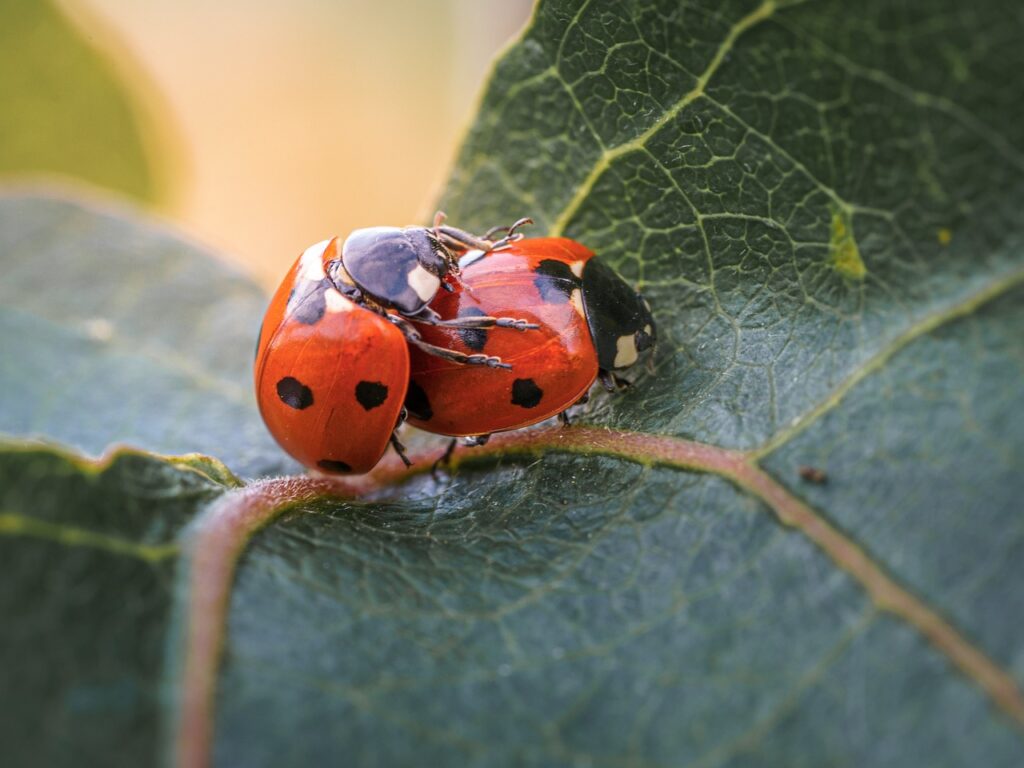

10. Powdery Mold
Powdery mold is another fungal disease that can affect zucchini plants. Unlike powdery mildew, which forms a white powder on the leaves, powdery mold appears as a grayish powder and can cause the plant to weaken and reduce its fruit production. This mold thrives in humid conditions and can spread quickly if not addressed.
Solution: Prevent powdery mold by ensuring your zucchini plants are well-spaced to allow for good air circulation. Water the plants at the base to avoid wetting the leaves, and avoid overhead watering, especially in the late afternoon or evening. If you notice signs of powdery mold, remove the affected leaves to prevent the spread of the disease. You can also treat the plants with a fungicide that is specifically designed to combat mold. Keeping the garden free of debris and maintaining proper plant hygiene will also help reduce the risk of powdery mold.

11. Bacterial Wilt
Bacterial wilt is a serious disease that can quickly kill zucchini plants. This disease is spread by cucumber beetles, which carry the bacteria in their mouthparts. Once a plant is infected, it will wilt rapidly and there is no cure. The bacteria clog the plant’s vascular system, preventing water and nutrients from reaching the leaves, which causes the plant to collapse.
Solution: The best way to prevent bacterial wilt is to control cucumber beetles in your garden. Use row covers to protect your plants, and set out traps to catch adult beetles. If you suspect a plant is infected with bacterial wilt, remove it immediately to prevent the disease from spreading to other plants. Crop rotation can also help reduce the risk of bacterial wilt, as the bacteria can persist in the soil for several years.
12. Zucchini Mosaic Virus
Zucchini Mosaic Virus is a viral disease that can cause severe damage to zucchini plants. The virus leads to distorted leaves, stunted growth, and mottled fruit, making the plant unproductive. It is spread by aphids and can also be transmitted through infected seeds. Once a plant is infected, there is no cure, and it can easily spread to other plants in the garden.
Solution: Prevent Zucchini Mosaic Virus by controlling aphid populations in your garden. Use insecticidal soap or neem oil to keep aphids at bay, and introduce natural predators like ladybugs and lacewings. Be cautious when purchasing seeds and only buy from reputable sources that guarantee disease-free seeds. If you notice symptoms of the virus, remove the affected plant immediately to prevent the spread of the disease. Avoid handling plants when they are wet, as the virus can spread through physical contact.
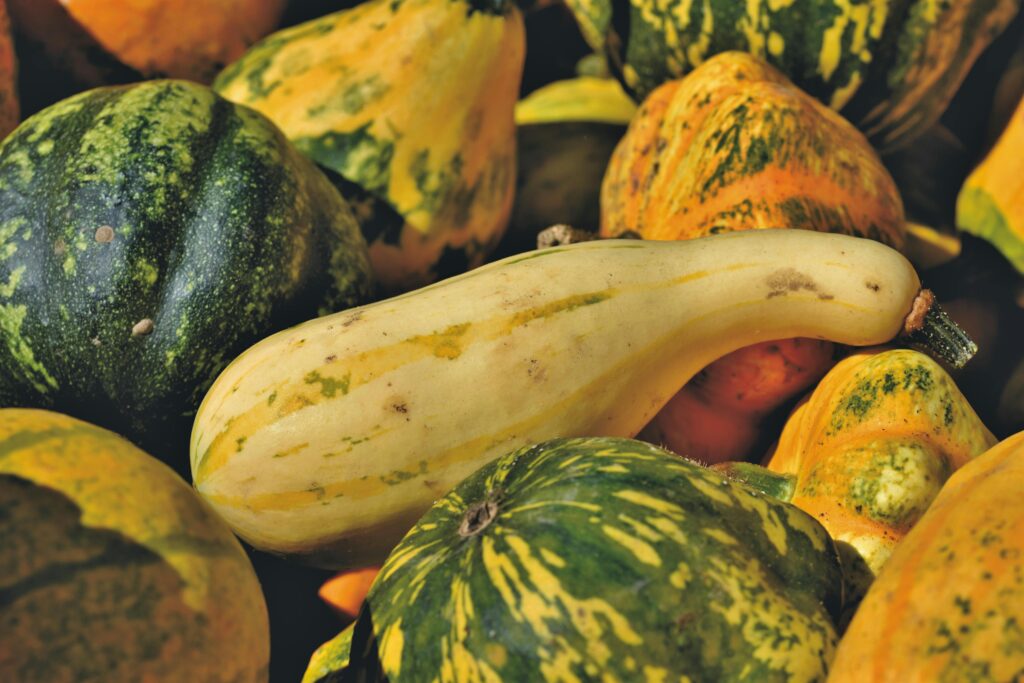
13. Environmental Stress
Environmental stress, such as extreme temperatures, can have a significant impact on zucchini plants. High temperatures can cause flowers to drop, reducing fruit set, while cold temperatures can stunt plant growth and delay fruit development. Additionally, sudden changes in weather, such as heavy rains or droughts, can stress the plants and make them more susceptible to diseases and pests.
Solution: Protect your zucchini plants from environmental stress by providing shade during hot weather and using row covers to protect them from cold temperatures. Mulching around the base of the plants can help regulate soil temperature and moisture levels, reducing the impact of temperature fluctuations. Regularly monitoring the weather forecast and adjusting your garden practices accordingly can help minimize the effects of environmental stress on your zucchini plants.

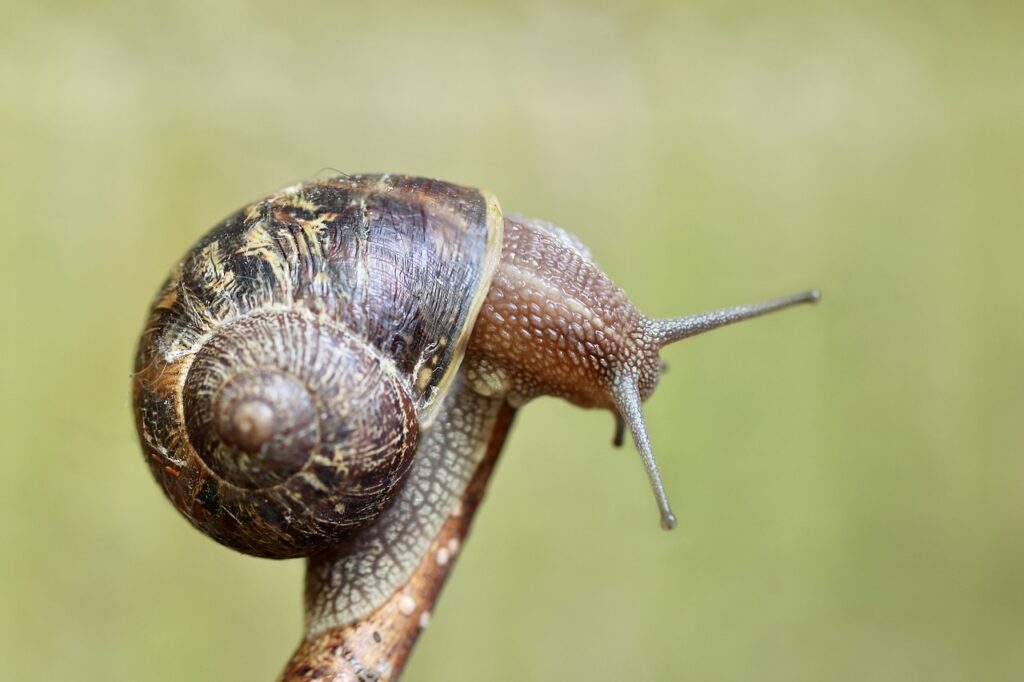
14. Pest Damage
In addition to squash vine borers, cucumber beetles, and aphids, other pests like slugs, snails, and whiteflies can damage zucchini plants. Slugs and snails feed on the leaves, leaving behind holes and slime trails, while whiteflies suck the sap from the leaves, causing them to yellow and curl. If left unchecked, these pests can weaken the plants and reduce fruit production.
Solution: To control slugs and snails, use organic methods like diatomaceous earth, copper tape, or beer traps. For whiteflies, use insecticidal soap or neem oil, and consider introducing natural predators like ladybugs or lacewings. Regularly inspect your plants for signs of pest damage and take action early to prevent the pests from spreading. Keeping your garden clean and free of debris can also reduce the habitats where pests can thrive.
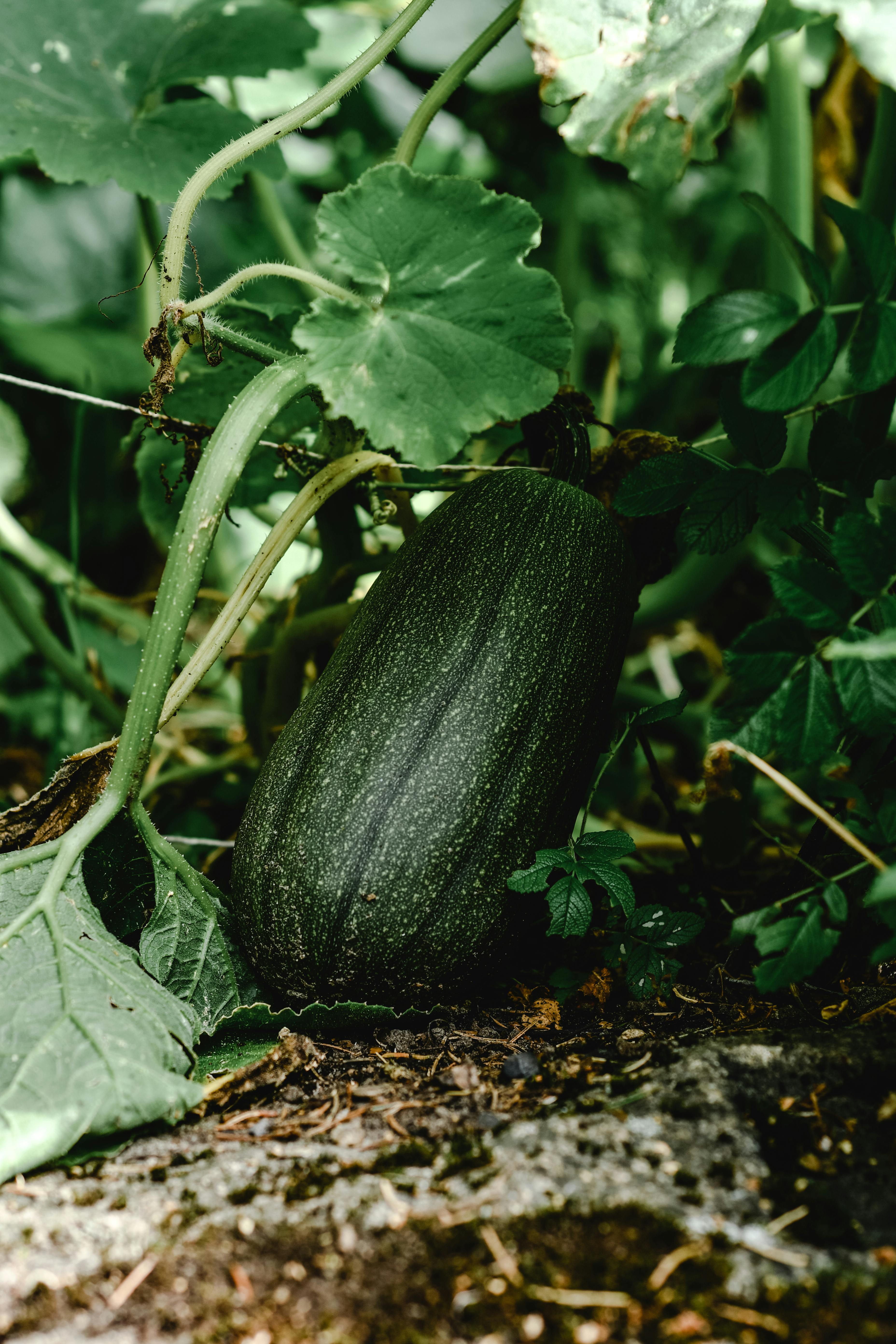
15. Poor Soil Quality
Poor soil quality can lead to a host of problems for zucchini plants, including nutrient deficiencies, poor drainage, and stunted growth. Zucchini plants thrive in rich, well-draining soil with plenty of organic matter. If the soil is too compacted, sandy, or lacking in nutrients, the plants will struggle to grow and produce fruit.
Solution: Before planting, amend your soil with compost or well-rotted manure to improve its structure and fertility. Conduct a soil test to determine if any additional amendments are needed, such as lime to raise the pH or sulfur to lower it. If your soil is heavy clay, consider planting zucchini in raised beds or adding organic matter to improve drainage. Regularly replenish the soil with organic matter throughout the growing season to maintain its health and support your zucchini plants.
Frequently Asked Questions about growing Zucchini
Why is my zucchini turning yellow and rotting on the vine?
Yellowing and rotting zucchini on the vine is often a sign of blossom end rot or poor pollination. Blossom end rot occurs due to a calcium deficiency, which is usually caused by inconsistent watering. When the plant can’t absorb calcium properly, the fruits develop a soft, yellowish spot that eventually rots. To prevent this, ensure your zucchini plants receive consistent moisture by watering deeply and regularly, especially during dry periods. Mulching around the base can help retain soil moisture.
Another cause could be poor pollination. If the female flowers aren’t adequately pollinated, the fruit may start to develop but will soon wither and rot. Encourage pollinators like bees by planting companion flowers nearby or try hand-pollinating by transferring pollen from male to female flowers using a small brush. Addressing these issues will help your zucchini plants produce healthy, vibrant fruits instead of yellow, rotting ones.
What is wrong with my zucchini plant?
If your zucchini plant isn’t thriving, several factors could be at play. Common issues include poor pollination, pest infestations, diseases, and nutrient deficiencies. If your zucchini fruits are small or misshapen, inadequate pollination may be the cause. Encourage pollinators like bees, or try hand-pollinating.
Pests such as squash bugs, vine borers, and aphids can weaken the plant, causing yellowing leaves, stunted growth, or wilting. Regularly inspect your plants and use organic pest control methods like neem oil or introducing beneficial insects.
Diseases like powdery mildew or blossom end rot can also affect zucchini plants. Powdery mildew appears as a white powder on leaves, while blossom end rot results in fruits rotting at the blossom end due to calcium deficiency. Ensure consistent watering and good air circulation to prevent disease.
Lastly, check for nutrient deficiencies by testing the soil and amend it with compost or fertilizer as needed.
Why are my zucchini dying before maturing?
If your zucchini plants are dying before maturing, the likely causes are poor pollination, blossom end rot, or environmental stress. Inadequate pollination results in fruits that start developing but soon wither and die. To combat this, encourage bees and other pollinators by planting flowers nearby or hand-pollinate by transferring pollen from male to female flowers with a brush.
Blossom end rot is another common issue, caused by a calcium deficiency due to inconsistent watering. It leads to fruits developing a brown, rotting spot at the blossom end. Ensure regular, deep watering to keep soil moisture consistent and consider mulching to retain moisture.
Environmental stress, such as extreme temperatures or fluctuating moisture levels, can also cause zucchini to fail before maturing. Protect plants from extreme heat with shade cloth and ensure they are well-watered during dry periods.
Why are my zucchini rotting while growing?
Zucchini rotting while growing is often due to blossom end rot or poor pollination. Blossom end rot occurs when the plant struggles to absorb enough calcium, leading to a soft, decayed spot at the fruit’s blossom end. Inconsistent watering is usually the cause, so it’s essential to maintain even soil moisture. Water deeply and regularly, especially during dry spells, and consider mulching to help retain moisture.
Another common issue is poor pollination. If the zucchini flowers aren’t pollinated effectively, the fruit may start to develop but will rot before fully maturing. To improve pollination, attract bees and other pollinators by planting companion flowers, or try hand-pollinating by transferring pollen from male to female flowers using a small brush.
Additionally, excessive moisture or poor drainage can promote fungal growth, leading to rotting fruits. Ensure your plants have well-draining soil and avoid overhead watering.
How do you treat blossom end rot on zucchini plants?
To treat blossom end rot on zucchini plants, focus on improving watering consistency and ensuring adequate calcium levels in the soil. Blossom end rot is often caused by a calcium deficiency, typically due to irregular watering that disrupts nutrient absorption. Start by watering deeply and consistently, keeping the soil evenly moist but not waterlogged. Mulching around the base of the plants helps retain moisture and maintain stable soil conditions.
Next, check your soil’s calcium levels. You can add calcium through lime, gypsum, or calcium sprays if the soil is deficient. Avoid excessive nitrogen fertilizers, as they can promote foliage growth at the expense of fruit development, worsening the problem.
If you spot early signs of blossom end rot, remove the affected fruits to prevent the plant from wasting energy on them. Over time, consistent care will reduce the occurrence of this issue, leading to healthier, more productive zucchini plants.
Should zucchini plants be watered every day?
Zucchini plants do not need to be watered every day, but they do require consistent moisture to thrive. Watering deeply and regularly is key, aiming to keep the soil evenly moist without becoming waterlogged. Typically, zucchini plants need about 1 to 2 inches of water per week, depending on weather conditions. In hot or dry climates, you may need to water more frequently, but avoid shallow, daily watering as it can lead to weak root development.
A good practice is to water zucchini plants in the morning to allow the foliage to dry out during the day, reducing the risk of fungal diseases. Mulching around the base of the plants can help retain moisture and prevent evaporation, allowing you to water less frequently. Monitor the soil and water when the top inch feels dry to the touch. Proper watering ensures healthy growth and productive zucchini plants.
What is the best fertilizer for zucchini?
The best fertilizer for zucchini is one that provides a balanced mix of nutrients, particularly nitrogen, phosphorus, and potassium. A 10-10-10 or 5-10-10 balanced fertilizer is ideal for zucchini, promoting healthy leaf growth and strong fruit development. Begin by applying a balanced, slow-release fertilizer at planting time to establish nutrient-rich soil.
As the plants grow, you can supplement with a side-dressing of fertilizer when they start flowering. For organic options, compost, well-rotted manure, or fertilizers like fish emulsion or blood meal can provide the necessary nutrients.
Be careful not to over-fertilize with nitrogen, as it can lead to excessive foliage growth at the expense of fruit production. Also, consider a soil test to determine specific nutrient needs and adjust the fertilizer accordingly. Regular feeding and proper soil preparation will help your zucchini plants thrive, resulting in abundant and healthy harvests.
Why are my zucchini plants wilting and dying?
Zucchini plants wilting and dying can be due to several factors, including water issues, pests, diseases, or environmental stress. Inconsistent watering, either too much or too little, can cause wilting. Ensure your plants receive consistent moisture by watering deeply and regularly, but avoid waterlogged soil which can lead to root rot.
Pests such as squash vine borers or cucumber beetles can also cause wilting. Check for signs of these pests and use appropriate control methods, like insecticidal soap or row covers, to protect your plants.
Diseases like bacterial wilt or powdery mildew can lead to wilting and plant death. Bacterial wilt is spread by cucumber beetles and requires removing infected plants to prevent spread. Powdery mildew can be managed with proper spacing for air circulation and fungicides.
Environmental stress, such as extreme temperatures or poor soil conditions, can exacerbate these problems. Regularly monitor and adjust care to keep your zucchini plants healthy.
How do I make my zucchini grow better?
To make your zucchini grow better, start by ensuring optimal growing conditions. Choose a sunny spot that receives at least 6 to 8 hours of direct sunlight daily, as zucchini plants thrive in bright light. Prepare well-draining soil rich in organic matter, such as compost or well-rotted manure, to provide essential nutrients and improve soil structure.
Regularly water your zucchini plants deeply, maintaining consistent soil moisture without waterlogging. Mulching around the base helps retain moisture and suppress weeds.
Fertilize with a balanced fertilizer, like a 10-10-10 formula, or use organic options such as compost or fish emulsion to support healthy growth and fruit development.
Practice good plant hygiene by removing any diseased or damaged leaves and providing adequate spacing to enhance air circulation, reducing the risk of fungal diseases. Regularly inspect for pests and manage them promptly.
Why is my zucchini failing to thrive?
If your zucchini is failing to thrive, several factors could be contributing to the problem. Common issues include inadequate sunlight, poor soil conditions, and inconsistent watering. Zucchini plants require at least 6-8 hours of direct sunlight daily to grow properly. Ensure they are planted in a sunny spot.
Soil quality is crucial; zucchini thrive in well-draining soil rich in organic matter. If your soil is too compacted or lacks nutrients, amend it with compost or well-rotted manure.
Inconsistent watering can also affect plant health. Zucchini plants need regular, deep watering to keep the soil evenly moist. Overwatering can lead to root rot, while underwatering can stress the plants.
Check for pests like squash bugs or diseases such as powdery mildew. Regularly inspect your plants, and take action to manage any issues promptly. Addressing these factors will help your zucchini plants grow robustly and produce a healthy harvest.
How do you tell if zucchini is overwatered?
Overwatered zucchini plants often show signs of stress that include yellowing leaves, wilting despite moist soil, and root rot. The soil around the plants may feel soggy or have standing water, indicating excessive moisture. Yellowing of the leaves, particularly the lower ones, is a key indicator of overwatering, as it often results from poor root health.
To prevent overwatering, ensure your zucchini plants are grown in well-draining soil and avoid watering them until the top inch of soil is dry. Mulching around the plants can help maintain consistent soil moisture and reduce the need for frequent watering.
If you suspect overwatering, reduce the frequency and amount of water you provide. Check that your garden beds or containers have adequate drainage to prevent water from accumulating.
What is the secret to growing zucchini?
The secret to growing zucchini successfully lies in providing the right conditions and consistent care. Start by choosing a sunny location that receives at least 6-8 hours of direct sunlight daily, as zucchini plants thrive in bright light. Prepare well-draining soil rich in organic matter, such as compost, to ensure optimal nutrient availability and root health.
Water zucchini plants deeply and regularly, maintaining consistent soil moisture without overwatering. Mulching helps retain moisture and prevent weed competition.
Fertilize with a balanced fertilizer or organic alternatives like compost or fish emulsion to support robust growth and fruit development. Ensure proper spacing to allow for adequate air circulation and reduce the risk of fungal diseases.
Monitor for pests and diseases, addressing issues promptly with appropriate treatments. Regularly inspect your plants and provide care tailored to their needs. By focusing on these factors, you’ll enhance your chances of a successful zucchini harvest.
What does Epsom salt do for zucchini plants?
Epsom salt, which contains magnesium sulfate, can benefit zucchini plants in several ways. Magnesium is essential for photosynthesis and helps plants produce chlorophyll, promoting vibrant, green foliage. Applying Epsom salt can help address magnesium deficiencies, which often manifest as yellowing leaves and poor growth.
To use Epsom salt, dissolve 1-2 tablespoons in a gallon of water and apply it to the soil around your zucchini plants or use it as a foliar spray. This treatment enhances nutrient uptake and supports overall plant health.
In addition to magnesium, Epsom salt can improve soil structure, helping with better water retention and drainage. However, it’s crucial to use Epsom salt sparingly, as excessive amounts can lead to nutrient imbalances. Regularly monitor your plants’ health and soil conditions to ensure that you’re providing the right amount of nutrients for optimal zucchini growth.
What kills zucchini?
Several factors can contribute to the death of zucchini plants. Key culprits include pests, diseases, and environmental stress. Pests such as squash vine borers and cucumber beetles can cause significant damage, leading to plant wilting and death. Regularly inspect your plants and apply appropriate pest control methods, such as insecticidal soap or neem oil, to manage infestations.
Diseases like powdery mildew and bacterial wilt can also threaten zucchini plants. Powdery mildew appears as a white, powdery substance on leaves and can be managed with proper spacing for air circulation and fungicides. Bacterial wilt, often spread by cucumber beetles, requires removing infected plants to prevent further spread.
Environmental stressors like extreme temperatures, poor soil drainage, or inconsistent watering can weaken zucchini plants, making them more susceptible to disease and pests. Ensure optimal growing conditions by providing consistent care, including proper watering, well-draining soil, and protection from extreme weather.
Should I cut off wilted zucchini leaves?
Yes, you should cut off wilted zucchini leaves to promote plant health and prevent potential disease spread. Wilted leaves can be a sign of several issues, including poor watering practices, pest infestations, or diseases. By removing these leaves, you help reduce the risk of diseases spreading to healthy parts of the plant and improve air circulation, which can reduce the likelihood of fungal infections.
When cutting off wilted leaves, use clean, sharp pruning shears to avoid introducing pathogens. Make sure to dispose of the removed leaves properly, especially if they are diseased, to prevent any potential spread.
Regularly inspect your zucchini plants and address any underlying issues causing the wilting. Ensure consistent watering, check for pests, and maintain good soil health to support overall plant vigor. By managing these factors and pruning wilted leaves, you can help your zucchini plants recover and thrive.
Are coffee grounds good for zucchini plants?
Yes, coffee grounds can be beneficial for zucchini plants when used correctly. Coffee grounds are rich in nitrogen, an essential nutrient that supports vigorous leaf growth and overall plant health. They can also improve soil structure by adding organic matter, enhancing drainage, and increasing moisture retention.
To use coffee grounds, mix them into the soil around your zucchini plants or add them to your compost pile. This helps integrate the nutrients into the soil and ensures they are available to the plants. Avoid using coffee grounds in excessive amounts, as too much can lead to soil acidity and potential nutrient imbalances.
Additionally, coffee grounds can act as a natural mulch, helping to suppress weeds and regulate soil temperature. However, it’s essential to use them in moderation and in combination with other compost materials for balanced soil nutrition. Proper application of coffee grounds supports healthy zucchini growth and productivity.
What to plant next to zucchini?
Planting companion plants next to zucchini can boost growth and improve yields. Ideal companions include herbs like basil and oregano, which can repel pests such as squash bugs and aphids. Marigolds are another excellent choice, as they deter harmful insects and enhance soil health with their natural compounds.
Beans are also great companions for zucchini. They fix nitrogen in the soil, enriching it and promoting vigorous plant growth. Additionally, planting nasturtiums near zucchini can help attract beneficial insects while deterring aphids and beetles.
Avoid planting zucchini next to other squash varieties or cucumbers, as they are prone to similar diseases and pests, which can lead to the spread of issues. Similarly, avoid planting zucchini near potatoes, which can compete for nutrients and space.
Why do my zucchini plants look like they are dying?
If your zucchini plants look like they are dying, several factors could be at play. First, check for signs of inadequate watering. Both overwatering and underwatering can stress plants, leading to wilted or yellowing leaves. Ensure you provide consistent moisture and avoid waterlogging the soil.
Pests such as squash vine borers or cucumber beetles can cause significant damage, resulting in dying plants. Inspect for pests and manage them with appropriate treatments, such as insecticidal soap or organic pest control methods.
Diseases like powdery mildew or bacterial wilt can also be responsible. Powdery mildew appears as a white, powdery coating on leaves and can be treated with fungicides and proper spacing for air circulation. Bacterial wilt, often spread by pests, requires removing affected plants to prevent further spread.
Environmental stress, such as extreme temperatures or poor soil quality, can exacerbate these issues.
How many zucchini does one plant produce?
One zucchini plant can produce between 6 to 15 zucchinis over its growing season, depending on various factors such as growing conditions, plant care, and variety. Under ideal conditions, including full sun exposure, well-draining soil, and consistent watering, a single plant can yield a substantial harvest.
Zucchini plants are prolific producers, and their productivity can be enhanced by regular harvesting. Harvesting zucchinis when they are small and tender encourages the plant to continue producing more fruit. Be sure to pick zucchinis every few days to prevent them from becoming oversized and to promote continued fruiting.
Proper fertilization and pest management also play a crucial role in maximizing zucchini yield. Using a balanced fertilizer and monitoring for pests can help ensure that your plant remains healthy and productive throughout the growing season.
Are eggshells good for zucchini?
Yes, eggshells can be beneficial for zucchini plants when used correctly. Eggshells are a rich source of calcium, which is essential for strong cell walls and healthy fruit development. Applying crushed eggshells to the soil can help prevent blossom end rot, a common issue caused by calcium deficiency.
To use eggshells, rinse them thoroughly and allow them to dry. Crush them into small pieces or grind them into a fine powder, then incorporate them into the soil around your zucchini plants. This improves soil calcium levels and supports robust plant growth.
Eggshells also help improve soil structure and drainage. They can be mixed into compost or used as a mulch to enhance soil health. However, ensure they are used in moderation and in conjunction with other soil amendments for balanced nutrition. Regularly monitor your plants for signs of nutrient deficiencies and adjust soil amendments accordingly.
Zucchini plants can be incredibly rewarding to grow, but they do come with their fair share of challenges. By understanding and addressing these common zucchini growing problems, you can ensure a healthy, productive garden. Whether you’re dealing with pests, diseases, or environmental stress, taking proactive steps and staying vigilant will lead to a bountiful zucchini harvest.

